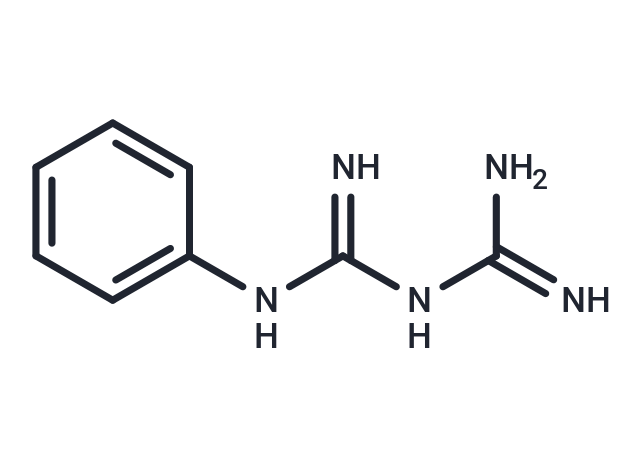Shopping Cart
- Remove All
 Your shopping cart is currently empty
Your shopping cart is currently empty

Phenylbiguanide (N-Phenylbiguanide) is a 5-HT3 receptor selective agonist(EC50 : 3.0±0.1 μM)

| Pack Size | Price | Availability | Quantity |
|---|---|---|---|
| 200 mg | $33 | In Stock | |
| 500 mg | $53 | In Stock | |
| 1 g | $77 | In Stock | |
| 1 mL x 10 mM (in DMSO) | $30 | In Stock |
| Description | Phenylbiguanide (N-Phenylbiguanide) is a 5-HT3 receptor selective agonist(EC50 : 3.0±0.1 μM) |
| Targets&IC50 | 5-HT3:3 μM (EC50) |
| In vivo | Phenylbiguanide (PBG) is a drug known to stimulate cardiopulmonary afferent C-fibres. PBG is injected into the right atrium of the heart in anaesthetised mice and mapped c-Fos expression within specific regions of the central nervous system. Intraatrial injection of PBG produces a reflex cardiorespiratory response including a pronounced bradycardia and a respiratory depression[1]. |
| Alias | PBG, N-Phenylbiguanide, 1-Phenylbiguanide |
| Molecular Weight | 177.21 |
| Formula | C8H11N5 |
| Cas No. | 102-02-3 |
| Smiles | N(C(NC(=N)N)=N)C1=CC=CC=C1 |
| Relative Density. | 1.2512 g/cm3 (Estimated) |
| Storage | Powder: -20°C for 3 years | In solvent: -80°C for 1 year | Shipping with blue ice. | |||||||||||||||||||||||||||||||||||
| Solubility Information | DMSO: 150 mg/mL (846.45 mM) | |||||||||||||||||||||||||||||||||||
Solution Preparation Table | ||||||||||||||||||||||||||||||||||||
DMSO
| ||||||||||||||||||||||||||||||||||||

Copyright © 2015-2024 TargetMol Chemicals Inc. All Rights Reserved.